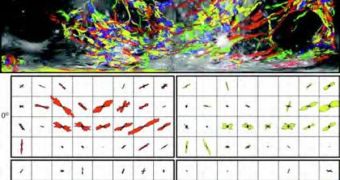After more than seven years of efforts poured into this initiative, experts can now finally boast the first geological map of Jupiter's moon Ganymede. This is only the third moon in the solar system to get such an “honor,” in addition to the Moon, and Jupiter's cratered Callisto. The detailed document will help astronomers gain a better insight into how the icy, natural satellite functions, Space reports.
“The map really gives us a more complete understanding of the geological processes that have shaped the moon we see today,” the leader of the map team, planetary scientist Wes Patterson, explains. He works at the Johns Hopkins University (JHU) Applied Physics Laboratory, in Laurel, Maryland. The expert will present details of the map today, at the European Planetary Science Congress, in Potsdam, Germany. Data from the NASA Voyager and the Galileo missions were used to create the document.
Ganymede holds a special place in the solar system because it is the only moon to have its own magnetosphere. With a diameter of 3,280 miles (5,262 kilometers), it's larger than the planet Mercury, and also dwarfs the small planet Ceres. Until now, only partial geological maps of the natural satellite existed, based on Voyager low-resolution images. Patterson's team is the first to combine these maps with high-resolution images taken by Galileo, into a comprehensive whole.
“By mapping the entirety of Ganymede's surface, we can more accurately address scientific questions regarding the formation and evolution of this truly unique moon. Work done using the map by collaborator Geoff Collins at Wheaton College, for instance, has shown that vast swaths of grooved terrain covering the surface of the satellite formed in a specific sequence. The details of this sequence tell us something about the forces that must have been necessary to form those swaths,” the expert adds. The geological features of the moon tell astronomers about the internal phenomena going on inside Ganymede.
The planned Europa Jupiter System Mission, devised by NASA and the European Space Agency (ESA), will include orbiters for Ganymede as well. “A primary goal of the next flagship mission to the Jupiter system will be to characterize, in detail, the geophysical, compositional, geological, and external processes that affect icy satellites. This map will be an invaluable tool in determining how best to address those goals for Ganymede,” Patterson concludes.

 14 DAY TRIAL //
14 DAY TRIAL //